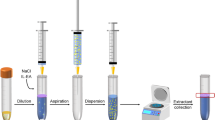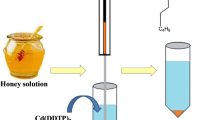Abstract
A rapid, simple, and sensitive method has been developed for the analysis of triazine herbicides in honey samples by using salt de-emulsification dispersive liquid-liquid microextraction and back-extraction (SD-DLLME-BE) coupled with sweeping in micellar electrokinetic chromatography (MEKC). In the newly developed method, chloroform can be generated by the reaction of chloral hydrate and sodium hydroxide, and the chloroform droplets dispersed into bulk aqueous solution can be swiftly carried to the bottom of the centrifuge tube with the addition of calcium chloride. Then, back-extraction was utilized to extract the analytes into an aqueous solution prior to capillary electrophoresis (CE) analysis. The advantages of the new in situ DLLME lie in dispersive solvent-free and no centrifugation operation compared with the conventional DLLME. Several important parameters influencing the preconcentration and extraction efficiency of SD-DLLME-BE such as sodium dodecyl sulfate (SDS) concentration, pH, chloral hydrate and sodium hydroxide content, extraction time, and calcium chloride content were optimized. Under the optimized conditions, the enrichment factors were achieved in the range from 459 to 636. The proposed method provided a good linearity, low limits of detection (8.56 ng/mL), and good repeatability of the extractions (relative standard deviations (RSDs) below 8.8 %, n = 6). Honey samples were analyzed by the proposed method, and obtained results indicated that the proposed method provides acceptable recoveries and precisions.



Similar content being viewed by others
References
Alshana U, Göğer NG, Ertas N (2013) Dispersive liquid-liquid microextraction combined with field-amplified sample stacking in capillary electrophoresis for the determination of non-steroidal anti-inflammatory drugs in milk and dairy products. Food Chem 138:890–897
Alshana U, Ertas N, Göğer NG (2015) Determination of parabens in human milk and other food samples by capillary electrophoresis after dispersive liquid-liquid microextraction with back-extraction. Food Chem 18:11–8
Andruch V, Balogh IS, Kocúrová L, Šandrejová J (2013) Five years of dispersive liquid-liquid microextraction. Appl Spectrosc Rev 48:161–259
Bagheri H, Khalilian F, Naderi M, Babanezhad E (2010) Membrane protected conductive polymer as micro-SPE device for the determination of triazine herbicides in aquatic media. J Sep Sci 33:1132–1138
Caldwell KA, Sadagopa Ramanujam VM, Cai Z, Gross ML, Spalding RF (1993) Herbicide trace analysis by high-resolution fast atom bombardment mass spectrometry: quantification of low parts per trillion levels of atrazine in water. Anal Chem 65:2372–2379
Cavalcante RM, Lima DM, Fernandes GM, Duaví WC (2012) Relation factor: a new strategy for quality control in the determination of pesticides in environmental aqueous matrices. Talanta 93:212–218
Cheng JH, Liu M, Zhang XY, Ding L, Yu Y, Wang XQ, Jin HY, Zhang HQ (2007) Determination of triazine herbicides in sheep liver by microwave-assisted extraction and high performance liquid chromatography. Anal Chim Acta 590:34–39
Cheng HY, Han C, Xu ZG, Liu JH, Wang YC (2014) Sensitivity enhancement by field-amplified sample injection in interfacing microchip electrophoresis with inductively coupled plasma mass spectrometry for bromine speciation in bread. Food Anal Methods 7:2153–2162
De Souza D, de Toledo RA, Galli A, Salazar-Banda GR, Silva MRC, Garbellini GS, Mazo LH, Avaca LA, Machado SAS (2007) A methodology without waste toxics for the electroanalytical determination of triazinics herbicides. A comparative study between voltammetric and chromatographic techniques. Anal Bioanal Chem 387:2245–2253
EU Pesticides database http://ec.europa.eu/sanco_pesticides/public/?event=homepage&language=EN. Accessed 2 March 2014
Herrera-Herrera AV, Hernandez-Borges J, Borges-Miquel TM, Rodriguez-Delgado MA (2010) Dispersive liquid-liquid microextraction combined with nonaqueous capillary electrophoresis for the determination of fluoroquinolone antibiotics in waters. Electrophoresis 31(20):3457–3465
Hidalgo C, Sancho JV, Hernández F (1997) Trace determination of triazine herbicides by means of coupled-column liquid chromatography and large volume injection. Anal Chim Acta 338:223–229
Kocúrová L, Balogh IS, Šandrejová J, Andruch V (2012) Recent advances in dispersive liquid–liquid microextraction using organic solvents lighter than water. A review. Microchem J 102:11–17
Li JH, Lu WH, Ma JP, Chen LX (2011) Determination of mercury(II) in water samples using dispersive liquid-liquid microextraction and back extraction along with capillary zone electrophoresis. Microchim Acta 175:301–308
Liang TT, Lv ZH, Jiang TF, Wang YH (2013) High-density extraction solvent-based solvent de-emulsification dispersive liquid-liquid microextraction combined with micellar electrokinetic capillary chromatography for detection of chlorophenols in water samples. Electrophoresis 34:345–352
Matamoros V, Jover E, Bayona JM (2009) Part-per-trillion determination of pharmaceuticals, pesticides, and related organic contaminants in river water by solid-phase extraction followed by comprehensive two-dimensional gas chromatography time-of-flight mass spectrometry. Anal Chem 82:699–706
Moliner-Martínez Y, Molins-Legua C, Verdú-Andrés J, Herráez-Hernández R, Campíns-Falcó P (2011) Advantages of monolithic over particulate columns for multiresidue analysis of organic pollutants by in-tube solid-phase microextraction coupled to capillary liquid chromatography. J Chromatogr A 1218:6256–6262
Norouzi P, Larijani B, Ganjali MR, Faridbod F (2012) Admittometric electrochemical determination of atrazine by nano-composite immune-biosensor using FFT Square wave voltammetry. Int J Electrochem Sci 7:10414–10426
Penalver A, Garcia V, Pocurull E, Borrull F, Marce RM (2003) Stir bar sorptive extraction and large volume injection gas chromatography to determine a group of endocrine disrupters in water samples. J Chromatogr A 1007:1–9
Peng JF, Lu JX, Hu XL, Liu JF, Jiang GB (2007) Determination of atrazine, desethyl atrazine and desisopropyl atrazine in environmental water samples using hollow fiber-protected liquid-phase microextraction and high performance liquid chromatography. Microchim Acta 158:181–186
Radišić MM, Vasiljević TM, Dujaković NN, Laušević MD (2013) Application of matrix solid-phase dispersion and liquid chromatography-ion trap mass spectrometry for the analysis of pesticide residues in fruits. Food Anal Methods 6:648–657
Rezaee M, Assadi Y, Milani Hosseini MR, Aghaee E, Ahmadi F, Berijani S (2006) Determination of organic compounds in water using dispersive liquid-liquid microextraction. J Chromatogr A 1116:1–9
Wang SF, Ye S, Cheng YY (2006) Separation and on-line concentration of saponins from Panax notoginseng by micellar electrokinetic chromatography. J Chromatogr A 1109:279–284
Wang YP, Sun Y, Xu B, Li XP, Jin R, Zhang HQ, Song DQ (2014) Magnetic ionic liquid-based dispersive liquid–liquid microextraction for the determination of triazine herbicides in vegetable oils by liquid chromatography. J Chromatogr A 1373:9–16
Wen YY, Li JH, Zhang WW, Chen LX (2011) Dispersive liquid-liquid microextraction coupled with capillary electrophoresis for simultaneous determination of sulfonamides with the aid of experimental design. Electrophoresis 32(16):2131–2138
Wu CX, Liu Y, Wu QH, Wang C, Wang Z (2012) Combined use of liquid–liquid microextraction and carbon nanotube reinforced hollow fiber microporous membrane solid-phase microextraction for the determination of triazine herbicides in water and milk samples by high-performance liquid chromatography. Food Anal Methods 5:540–550
Xue Y, Chen N, Luo C, Wang X, Sun C (2013) Simultaneous determination of seven preservatives in cosmetics by dispersive liquid–liquid microextraction coupled with high performance capillary electrophoresis. Anal Methods 5(9):2391–2397
Ye CL, Zhou QX, Wang XM (2007) Improved single-drop microextraction for high sensitive analysis. J Chromatogr A 1139:7–13
Zhang Y, Xu H (2014) Determination of triazoles in tea samples using dispersive solid phase extraction combined with dispersive liquid–liquid microextraction followed by liquid chromatography-tandem mass spectrometry. Food Anal Methods 7:189–196
Zhang SH, Yang XM, Yin XF, Wang C, Wang Z (2012) Dispersive liquid-liquid microextraction combined with sweeping micellar electrokinetic chromatography for the determination of some neonicotinoid insecticides in cucumber samples. Food Chem 133:544–550
Zhang HY, Zhang ZJ, Wang ZC, Liang YH (2013) Determination of aromatic amines by sedimentation accelerated inorganic salt-dispersive liquid-liquid microextraction capillary zone electrophoresis. Chin J Anal Chem 41:1875–1880
Zhou CH, Tong SS, Chang YX, Jia Q, Zhou WH (2012) Ionic liquid-based dispersive liquid–liquid microextraction with back-extraction coupled with capillary electrophoresis to determine phenolic compounds. Electrophoresis 33:1331–1338
Compliance with Ethical Standards
ᅟ
Funding
This study was funded by the Science and Technology Development Plan Project of Shandong Province (2014GSF121003), Key Laboratory of Sensor Analysis of Tumor Marker (Qingdao University of Science and Technology), Ministry of Education, and the Natural Science Foundation of Shandong Province (ZR2011BM004).
Conflict of Interest
Mei-E Yue declares that she has no conflict of interest. Qian Li declares that she has no conflict of interest. Ting-Fu Jiang declares that he got grant from Shandong Province (2014GSF121003 and ZR2011BM004). Jie Xu declares that she has no conflict of interest.
Informed Consent
Additional informed consent was obtained from all individual participants for whom identifying information is included in this article.
Ethical Standards
This article does not contain any studies with human participants or animals performed by any of the authors.
Author information
Authors and Affiliations
Corresponding author
Rights and permissions
About this article
Cite this article
Yue, ME., Li, Q., Xu, J. et al. Salt De-Emulsification Dispersive Liquid-Liquid Microextraction and Back-Extraction Combined with Sweeping Micellar Electrokinetic Capillary Chromatography for Detection of Triazine Herbicides in Honey. Food Anal. Methods 9, 699–705 (2016). https://doi.org/10.1007/s12161-015-0231-6
Received:
Accepted:
Published:
Issue Date:
DOI: https://doi.org/10.1007/s12161-015-0231-6




